By: Niccolo Paganini
Week: 1
Music lessons over the next two years group musical instruments into five major categories: strings, keyboards, percussion, brass, and woodwinds. This year covers string, keyboard, and percussion instruments. Lessons first focus on string instruments, which are musical instruments played by striking strings, plucking strings, or drawing a bow across strings. The next four weeks present a string instrument called a violin. Violins typically have a small wooden body, a long neck, and four strings that musicians pluck with their fingers or rub with a bow. The musical composition for this lesson, '24 Caprices for Solo Violin, Op. 1, No. 20,' by Niccolo Paganini, features the violin. As you enjoy the music, identify the sounds of the violin. Listen to a lone violin playing in Activity 5 below for reference.
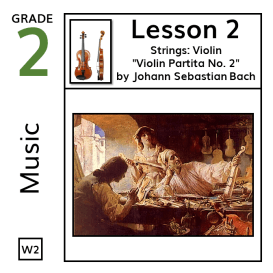
By: Johann Sebastian Bach
Week: 2
This lesson continues the study of the violin, a string instrument. The musical composition for this lesson, 'Violin Partita no. 2, BWV 1004 – Chaconne,' by Johann Sebastian Bach, features the violin. As you enjoy the music, identify the sounds of the violin. If desired, review the sound of a lone violin playing in Activity 5. The lesson image, 'Antonio Stradivari,' by Edgar Bundy, features the famous luthier in his workshop crafting his famous 'Stradivarius' instruments. Today, some Stradivarius violins sell for between two to three million dollars.
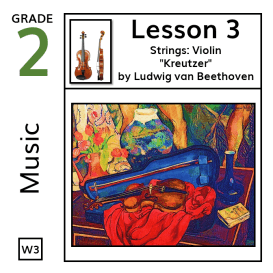
By: Ludwig van Beethoven
Week: 3
This lesson continues the study of the violin, a string instrument. The musical composition for this lesson, 'Violin Sonata no. 9 'Kreutzer', Op. 47,' by Ludwig van Beethoven, features the violin. As you enjoy the music, identify the sounds of the violin. If desired, review the sound of a lone violin playing in Activity 5. The still life painting featured in the lesson, 'The Violin Case,' by French painter Suzanne Valadon, uses vivid colors to depict a violin within a protective case.
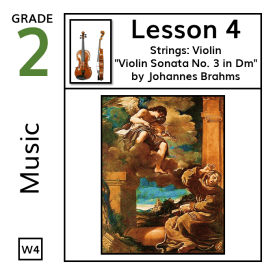
By: Johannes Brahms
Week: 4
This lesson completes the study of the violin, a stringed instrument. The musical composition for this lesson, 'Violin Sonata No. 3 in Dm, Op. 108,' by Johannes Brahms, features the violin. The still life painting featured in the lesson, 'St Francis with an Angel Playing Violin,' by Italian painter Guercino, shows friar and preacher Saint Francis of Assisi shielding his eyes from the glory of an angel. The angel sits on a cloud and plays the violin. A building, perhaps a church, breaks the horizon in the background.
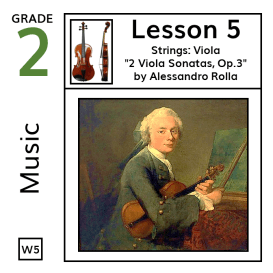
By: Alessandro Rolla
Week: 5
The next four weeks introduce a new string instrument called a viola. Like violins, violas typically have a wooden body, a long neck, and four strings that musicians pluck with their fingers or rub with a bow. However, violas are larger than violins and produce a lower and mellower sound. The musical composition for this lesson, '2 Viola Sonatas, Op.3,' by Alessandro Rolla, features the viola. As you enjoy the music, identify the sounds of the viola. Listen to a lone viola playing in Activity 5 below for reference. The painting included in the lesson, 'Young Man with a Viola,' by painter Chardin, shows a man holding a viola and a bow.
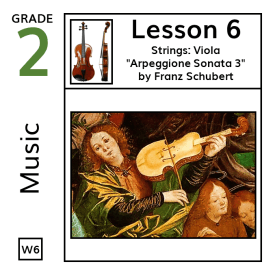
By: Franz Schubert
Week: 6
This lesson continues the study of the viola, a stringed instrument. The musical composition for this lesson, 'Arpeggione Sonata 3 (Allegro) for Viola and Orchestra,' by Franz Schubert, features the viola. As you enjoy the music, identify the sounds of the viola. Listen to a lone viola playing in Activity 5 below for reference. The painting included in the lesson, 'Viola da braccio,' by painter Gaudenzio Ferrari, shows a haloed woman holding a viola da braccio, the ancestor of the modern viola, and a bow.
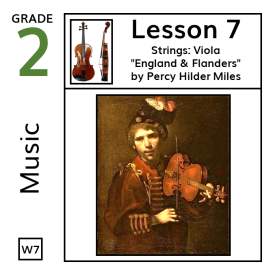
By: Percy Hilder Miles
Week: 7
This lesson continues the study of the viola, a stringed instrument. The musical composition for this lesson, 'England and Flanders for Viola and Piano,' by Percy Hilder Miles, features the viola. As you enjoy the music, identify the sounds of the viola. Listen to a lone viola playing in Activity 5 below for reference. The painting included in the lesson, 'Young Man Playing a Viola,' by painter Pietro Paolini, shows a young uniformed man playing a viola.
By: Johan Halvorsen
Week: 8
This lesson completes the study of the viola, a stringed instrument. The musical composition for this lesson, 'Passacaglia for Violin and Viola,' by Johan Halvorsen, features the violin and the viola. As you enjoy the music, identify the sounds of the viola. Listen to a lone viola playing in Activity 5 below for reference. The painting included in the lesson, 'Portrait of a Musician,' by an unknown painter, shows a viola and a bow on the wall behind a man holding a cello.
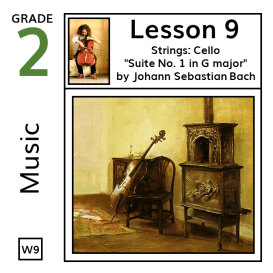
By: Johann Sebastian Bach
Week: 9
The next four weeks introduce a new string instrument called a cello. Like violins and violas, cellos typically have a wooden body, a long neck, and four strings that musicians pluck with their fingers or rub with a bow. However, cellos are much larger than violins or violas and produce a sound even mellower and lower than violas. In addition, musicians do not tuck cellos beneath their chins as with violins and violas. Instead, musicians sit to play the cello and hold the cello between their knees. A rod extends from the bottom of the cello, called an endpin, and rests on the ground. The musical composition for this lesson, 'Cello Suite No.1 in G major,' by Johann Sebastian Bach, features the cello. As you enjoy the music, identify the sounds of the cello. Listen to a lone cello playing in Activity 5 below for reference. The painting included in the lesson, 'Interior with a Cello,' by Carl Holsøe, shows a cello propped up in a room.
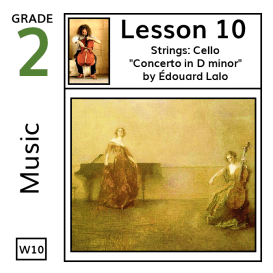
By: Édouard Lalo
Week: 10
The musical composition for this lesson, 'Cello Concerto in D minor,' by Édouard Lalo, features the cello. As you enjoy the music, identify the sounds of the cello. Listen to a lone cello playing in Activity 5 below for reference. The painting included in the lesson, 'The Song and the Cello,' by Thomas Wilmer Dewing, shows a one woman singing and another playing the cello.
By: Franz Joseph Haydn
Week: 11
This lesson continues the study of the cello, a stringed instrument. The musical composition for this lesson, 'Cello Concerto No. 1 in C major,' by Franz Joseph Haydn, features the cello. As you enjoy the music, identify the sounds of the cello. Listen to a lone cello playing in Activity 5 below for reference. The painting included in the lesson, 'The Sense of Hearing,' by Philip Mercier Dewing, shows a one woman singing and another playing the cello.
By: Luigi Boccherini
Week: 12
This lesson completes the study of the cello, a stringed instrument. The musical composition for this lesson, 'Cello Concerto No. 9 in B-flat major,' by Luigi Boccherini, features the cello. As you enjoy the music, identify the sounds of the cello. Listen to a lone cello playing in Activity 5 below for reference. The painting included in the lesson, 'Cello Player,' by Amedeo Modigliani, shows a bearded man in a blue jacket playing the cello.
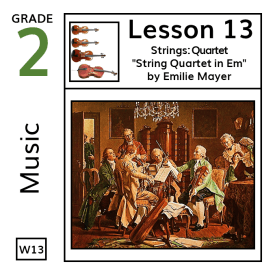
By: Emilie Mayer
Week: 13
This lesson introduces the string quartet, a grouping of four string instruments consisting of two violins, a viola, and a cello. The musical composition for this lesson, 'String Quartet in E minor,' by Emilie Mayer, features the music of a string quartet. As you enjoy the music, try to break out the sounds of the violins, the viola, and the cello. The painting included in the lesson, 'Joseph Haydn Playing Quartets,' by an anonymous artist, shows four seated men playing together as a string quartet. Another man stands next to them, perhaps acting as the conductor for the group. Servants peek in from behind a cracked door to listen. A group of three ladies lean in to hear better.
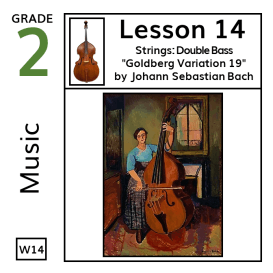
By: Johann Sebastian Bach
Week: 14
This lesson introduces the double bass, another stringed instrument. Like violins, violas, and cellos, double basses typically have a wooden body, a long neck, and four strings that musicians pluck with their fingers or rub with a bow. However, double bases are the largest instruments and produce the lowest and deepest sound. Musicians may stand or sit to the play the double bass. The musical composition for this lesson, 'Goldberg Variation 19,' by Johann Sebastian Bach, features the music of a double bass. The painting included in the lesson, 'The Woman with the Double Bass,' by Suzanne Valadon, shows a woman standing and playing a double bass.
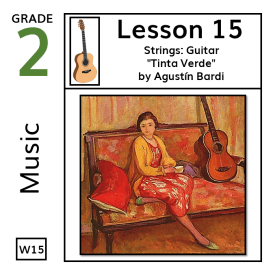
By: Agustín Bardi
Week: 15
This lesson introduces the guitar, a stringed instrument. Guitars have a wooden body, a long neck, and six strings that musicians strum or pluck with their fingers or a plectrum (guitar pick). The musical composition for this lesson, 'Tinta Verde,' by Agustín Bardi, features the music of a guitar. The painting included in the lesson, 'Nono and a Guitar,' by Henri Lebasque, shows a woman sitting next to a guitar.
By: Isaac Albéniz
Week: 16
This lesson continues the study of the guitar, a stringed instrument. Guitars have a wooden body, a long neck, and six strings that musicians strum or pluck with their fingers or a plectrum (guitar pick). The musical composition for this lesson, 'Asturias (Leyenda), from Suite Española Op. 47,' by Isaac Albéniz, features the music of a guitar. The painting included in the lesson, 'Young Spanish Woman with a Guitar,' by Pierre-Auguste Renoir, shows a woman playing a guitar.
By: Agustin Barrios Mangore
Week: 17
This lesson continues the study of the guitar, a stringed instrument. Guitars have a wooden body, a long neck, and six strings that musicians strum or pluck with their fingers or a plectrum (guitar pick). The musical composition for this lesson, 'Maxixe,' by Agustin Barrios Mangore, features the music of a guitar. The painting included in the lesson, 'Woman with Guitar,' by Aristarkh Vasilyevich Lentulov, shows a woman playing a guitar.
By: William Riley
Week: 18
This lesson continues the study of the guitar, a stringed instrument. Guitars have a wooden body, a long neck, and six strings that musicians strum or pluck with their fingers or a plectrum (guitar pick). The musical composition for this lesson, 'Twelve Spanish Dances, Op. 5 - Arabesca,' by William Riley, features the music of a guitar. The painting included in the lesson, 'The Guitar Player,' by Johannes Vermeer, shows a woman playing a guitar.
By: Henry Kailimai
Week: 19
This lesson introduces the ukulele, a stringed instrument. Ukuleles, or ukes for short, typically have a wooden body, a long neck, and four strings that musicians strum or pluck with their fingers. Ukuleles are smaller than guitars and have a higher pitched sound. The musical composition for this lesson, 'Kailimai's Hene,' by Henry Kailimai, features the music of a ukulele. The painting included in the lesson, 'Kolomona: Hawaiian Troubadour,' by Hubert Vos, shows a man playing a ukulele.
By: Tom Turpin
Week: 20
This lesson introduces the banjo, a stringed instrument. Banjos typically have a membrane stretched over a circular frame, a long neck, and between four to six strings that musicians strum or pluck with their fingers or a plectrum. The musical composition for this lesson, 'Buffalo Rag,' by Tom Turpin, features the music of a banjo. The painting included in the lesson, 'Cowboy Singing,' by Thomas Eakins, shows a cowboy playing a banjo.
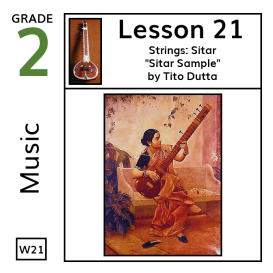
By: Tito Dutta
Week: 21
This lesson introduces the sitar, a stringed instrument. Sitars typically have a gourd-shaped body made from a dried pumpkin or wood, a long neck, and between eighteen and twenty-one strings. Musicians strum six or seven of these strings that run over frets. The remainder of the strings are sympathetic. They run under the frets and resonate along with the played strings. The musical composition for this lesson, 'Sitar Sample,' by Tito Dutta, features the music of a sitar. The painting included in the lesson, 'Kadambari,' by Raja Ravi Varma, shows a woman playing a sitar.
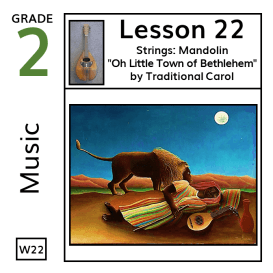
By: Traditional Carol
Week: 22
This lesson introduces the mandolin, a stringed instrument of the lute family. Mandolins typically have a wooden body with one or more sound holes, between eight to twelve strings arranged in four to six pairs, and a long neck. Mandolins are typically played with a plectrum (pick). The musical composition for this lesson, 'Oh Little Town of Bethlehem,' a traditional carol, features the music of a mandolin. The painting included in the lesson, 'The Sleeping Gypsy,' by Henri Rousseau, shows a man sleeping next to a mandolin.
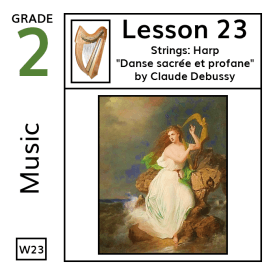
By: Claude Debussy
Week: 23
This lesson introduces the harp, a stringed instrument. Harps typically have a triangular frame strung with between 40 to 47 strings. Harps are plucked or strummed with the fingers. The musical composition for this lesson, 'Danse sacrée et danse profane,' by Claude Debussy, features the music of a harp. The painting included in the lesson, 'The Harp of Erin' by Thomas Buchanan Read, shows a woman chained to a rock and playing a harp on the rocky shore of the ocean.
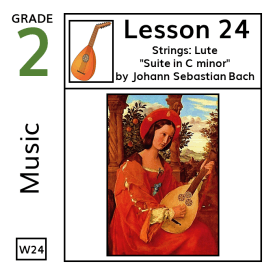
By: Johann Sebastian Bach
Week: 24
This lesson introduces the lute, a stringed instrument. Lutes typically have a long neck and an egg-shaped chamber strung with a varying number of strings. Lutes also have a sound hole called a rose. Lutes are plucked with a pick or strummed with the fingers. The musical composition for this lesson, 'Suite in C minor,' by Johann Sebastian Bach, features the music of a lute. The painting included in the lesson, 'Portrait of Mrs. Klara Bianka of Quandt with Lute,' by Julius Schnorr von Carolsfeld, shows a woman playing a lute.
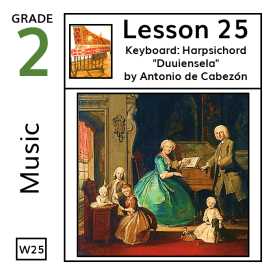
By: Antonio de Cabezón
Week: 25
The next several lessons feature instruments with keyboards. This lesson introduces the harpsichord, a keyboard instrument. Some categorizations of instruments classify harpsichords as string instruments, for harpsichords have strings. Unlike string instruments such as violins, guitars, and lutes, people do not strum or pluck the strings of harpsichords directly. Instead, people press keys and a mechanism inside the harpsichord plucks its strings. Popular in the late 18th century, the harpsichord was eventually replaced by the piano. The musical composition for this lesson, 'Duuiensela,' by Antonio de Cabezón, features the music of a harpsichord. The painting included in the lesson, 'Family Group at a Harpsichord,' by Cornelis Troost, shows a family gathered around a harpsichord.
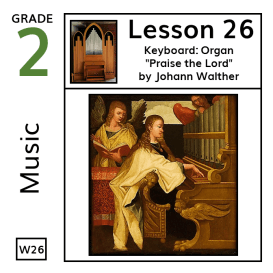
By: Johann Gottfried Walther
Week: 26
This lesson introduces the organ, a keyboard instrument. Unlike harpsichords, organs do not produce sounds by plucking strings. Instead, organs produce sound by moving air through pipes of various sizes. Musicians press keys with their fingers and pedals with their feet to control the sound. The musical composition for this lesson, 'Lobe den Herren (Praise the Lord),' by Johann Gottfried Walther, features the music of an organ. The painting included in the lesson, 'St. Cecilia at the Organ,' shows a women playing an organ next to two angels.
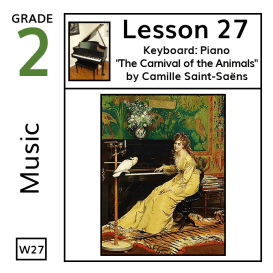
By: Camille Saint-Saëns
Week: 27
This lesson introduces the piano, a keyboard instrument. Pianists produce sounds by pressing keys with their fingers, which trigger a mechanism that strikes strings with little hammers. Musicians also press pedals with their feet to control the sound. The musical composition for this lesson, 'The Carnival of the Animals Mv. 1, 5, 7, and 8,' by Camille Saint-Saëns, features the music of a piano. The painting included in the lesson, 'Woman at the Piano with Cockatoo,' by Gustave de Jonghe, shows a women pressing a few piano keys while gazing at a cockatoo.
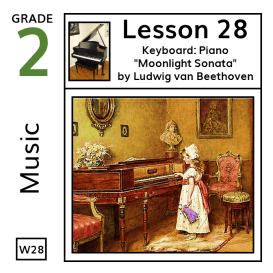
By: Ludwig van Beethoven
Week: 28
This lesson continues the study of the piano. This course classifies the piano as a keyboard instrument. Other classifications categorize pianos as string instruments, as pianos have strings. Still other classifications group pianos into the percussion group, since pianos have small hammers that strike the strings to create sounds. The musical composition for this lesson, 'Moonlight Sonata,' by Ludwig van Beethoven, features the music of a piano. The painting included in the lesson, 'Piano Practice,' by G. G. Kilburne, shows a little girl pushing a single key of a piano.
By: Wolfgang Amadeus Mozart
Week: 29
This lesson continues the study of the piano. The musical composition for this lesson, 'Rondo alla turca (Turkish March),' by Wolfgang Amadeus Mozart, features the music of a piano. The painting included in the lesson, 'Piano Lesson,' by Henriëtte Ronner-Knip, shows a mother cat and her kittens playing on a piano.
By: Ludwig van Beethoven
Week: 30
This lesson introduces the piano, a keyboard instrument. Pianists produce sounds by pressing keys with their fingers, which trigger a mechanism that strikes strings with little hammers. Musicians also press pedals with their feet to control the sound. The musical composition for this lesson, 'Pathetique,' by Ludwig van Beethoven, features the music of a piano. The painting included in the lesson, 'Liszt at the Piano,' by Josef Danhauser, shows a group of people listening to Liszt, the famous composer, play the piano.
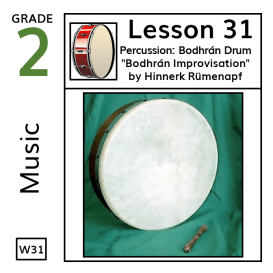
By: Hinnerk Rümenapf
Week: 31
The next several lessons feature percussion instruments. Percussion instruments include those struck with the hand, struck with a mallet or stick, or those that are shaken. This lesson introduces the bodhrán drum, an Irish percussion instrument. To make music, percussionists strike the bodhrán drum with a cipín. The musical composition for this lesson, 'Bodhrán Improvisation,' by Hinnerk Rümenapf, features the music of a bodhrán drum. The photograph included in the lesson, 'Bodhran,' by RichL, shows a bodhrán drum and a cipín.
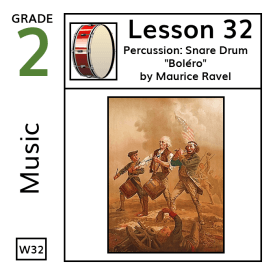
By: Maurice Ravel
Week: 32
This lesson features a percussion instrument called a snare drum, a staple of bands, orchestras, and marching bands. To make music, percussionists strike the snare drum with drumsticks. The musical composition for this lesson, 'Boléro,' by Maurice Ravel, features the constant beat of a snare drum. The lesson painting, 'The Spirit of '76,' by Archibald Willard, shows a man and a boy playing snare drums on a civil war battlefield. The American flag waves among clouds of smoke. Soldiers remove their hats in a show of respect for the flag, including one who is badly wounded.
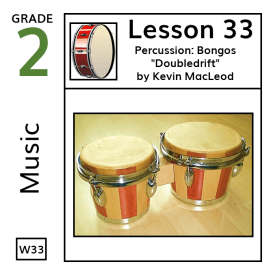
By: Kevin MacLeod
Week: 33
This lesson features a percussion instrument called a bongo drum or bongos. Bongos typically come in pairs, the larger bongo called the hembra (female), and the smaller bongo called the macho (male). To make music, percussionists strike bongos with their hands. The musical composition for this lesson, 'Doubledrift,' by Kevin MacLeod, features a bongo drum solo at the beginning. The lesson picture shows a pair of bongos.
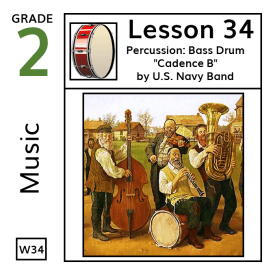
By: Unknown
Week: 34
This lesson features a percussion instrument called a bass drum. To make music, percussionists strike the bass drum with a large mallet. The musical composition for this lesson, 'Cadence B,' by an unknown composer, features the steady beat of a bass drum underneath the faster rhythm of a snare drum. As you enjoy the music, identify the sounds of the bass drum. Listen to a bass drum in Activity 3 for reference. The lesson painting, 'Klezmer Group,' by Mitaskim, shows a man and a boy playing snare drums on a civil war battlefield.
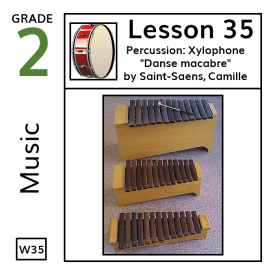
By: Camille Saint-Saëns
Week: 35
This lesson features a percussion instrument called a xylophone. To make music, percussionists strike the xylophone with two mallets, one held in each hand. The musical composition for this lesson, 'Danse macabre Opus 40,' by Camille Saint-Saens, features the tones of the xylophone. As you enjoy the music, identify the sounds of the xylophone (for example, at around 1:43 and 3:43). Listen to a xylophone in Activity 2 for reference. The lesson photo shows three xylophones and a mallet.
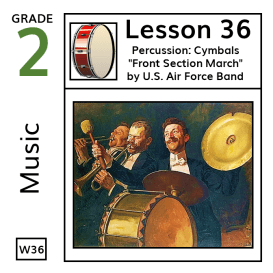
By: Edwin Eugene Bagley
Week: 36
This lesson features a percussion instrument called the cymbal. To make music, percussionists either strike two cymbals together or they hit a cymbal with a stick or mallet. The musical composition for this lesson, 'Front Section March,' by Edwin Eugene Bagley, features the clash of the cymbals. As you enjoy the music, identify the sounds of the cymbal. Listen to a cymbal roll in Activity 4 for reference. The lesson painting, 'Fanfare - Serenade,' by Stanisław Lentz, shows three men playing music. The closest musician holds a golden cymbal, ready to strike it against the cymbal mounted on the bass drum.